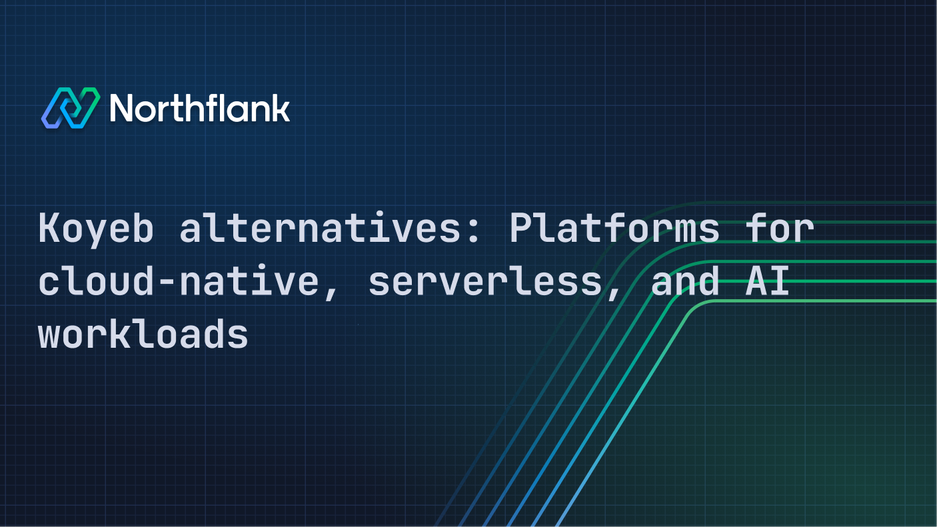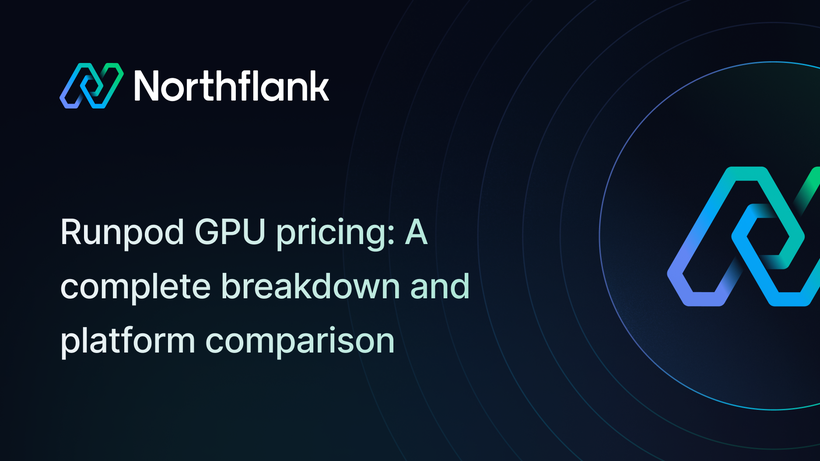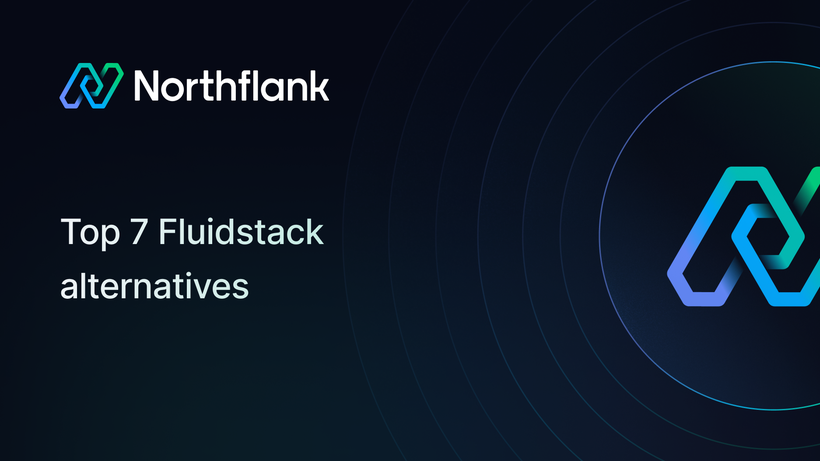

Koyeb alternatives: Platforms for cloud-native, serverless, and AI workloads
Koyeb made waves as a simple, serverless platform for deploying containers and web services, but as teams scale, priorities shift. Maybe you’ve hit a wall with pricing. Maybe you need deeper configurability, better support for background workers, or tighter control over your infrastructure. Or maybe you're just wondering if there’s something faster, cheaper, or more powerful out there.
This guide breaks down the best Koyeb alternatives available today. Whether you're deploying full-stack apps, running scheduled jobs, experimenting with AI workloads, or just want better DX, there's likely a better fit depending on your specific needs.
No fluff. Just real-world options, tradeoffs, and recommendations.
If you're short on time or just need a quick overview, here's a curated list of the top alternatives to Koyeb. Each option includes a one-liner on what it's best suited for—whether you're running containerized workloads, deploying ML models, or looking for the best developer experience.
- Northflank – Full-featured platform for containers, cron jobs, and AI workloads. Offers GPU support, bring your own cloud(BYOC), private networking, and strong enterprise features.
- Render – Developer-friendly PaaS with support for Docker, background workers, and monorepos. Great for full-stack apps but lacks GPU or BYOC capabilities.
- Fly.io – Global container platform for latency-sensitive and distributed apps. Offers GPU access and edge deployment, but has a steeper learning curve.
- Heroku – Classic PaaS with simple DX and support for multiple languages. Ideal for MVPs and fast prototyping, but outdated for modern infrastructure needs.
- DigitalOcean App Platform – Easy-to-use option for small teams deploying static sites or simple web apps. Limited support for containers and no GPU capabilities.
- Cloudflare Workers – Lightweight, globally distributed platform for serverless functions and APIs. Not container-based, but excellent for edge logic and fast response times.
Koyeb streamlines application deployment by abstracting away infrastructure management. Its key features include:
- Global edge deployments
- Automatic HTTPS and load balancing
- Git-based deployments
- Dockerfile and buildpack support
- Autoscaling, including scale-to-zero
- CLI and web dashboard with developer-friendly UX
These features make it appealing for quickly launching APIs, microservices, or full-stack applications without worrying about Kubernetes or underlying cloud providers.
Despite its polish and ease of use, Koyeb has some constraints that drive teams to explore alternatives:
- GPU support is limited to a single region and is still in early preview. This can be a dealbreaker for production AI workloads.
- No BYOC (Bring Your Own Cloud) or private VPC networking. You are fully tied to Koyeb's infrastructure.
- Limited regional control. While Koyeb uses a global edge network, developers have less granular control over where apps are deployed.
- Observability features are basic. There is no integrated distributed tracing, customizable metrics, or advanced logs beyond the standard output.
- Team and security features are minimal. Larger teams may require audit logs, SSO, fine-grained roles, and other enterprise-grade features not yet supported.
- Limited database support. Only PostgreSQL is natively supported, which may not suit more diverse data workloads.
- No support for preview environments. Useful for testing changes in isolation before merging, but missing from Koyeb’s default toolset.
- Infra-as-code dependency for advanced use cases. While Koyeb offers a CLI and Git-based deployments, some advanced configurations—like secrets management, custom networking, or service discovery—often require additional tooling like Terraform or Pulumi. For teams used to self-service platforms like Northflank, this can feel like an unnecessary DevOps tax.
Below is a detailed review of leading platforms that can replace or extend what Koyeb offers. These platforms vary in scope, from developer-centric PaaS tools to full infrastructure platforms with greater flexibility.
Northflank is a platform that enables developers to build, deploy, and scale applications, services, databases, jobs, and GPU workloads on any cloud through a self-service approach. For DevOps and platform teams, Northflank provides a powerful abstraction layer over Kubernetes, enabling templated, standardized production releases with intelligent defaults while maintaining necessary configurability.
Northflank advances the legacy of pioneers like Heroku and Pivotal Cloud Foundry. While Heroku perfected the self-service developer experience, it didn't support complex workloads in enterprise cloud accounts. Cloud Foundry offered the right application abstraction to simplify complexity, but its underlying infrastructure proved costly and difficult to implement. Northflank delivers the best of both worlds: support for complex workloads, exceptional developer experience, and appropriate abstractions in your cloud environment—all within minutes and at a reasonable cost.

Key Features:
- General Availability GPU support (A10, A100, H100, H200, and more)
- Bring your own cloud (AWS, Azure, GCP, and more) and connect to existing VPCs
- CI/CD pipelines, Dockerfile builds, and cron jobs.
- Autoscaling, including scale-to-zero
- Built-in logging, metrics, and observability tools
- Team collaboration features, including role-based access and environments
- Persistent volumes, managed databases (PostgreSQL, MongoDB, and more), and object storage
- Automatic preview environments and seamless promotion to dev, staging, and production
- Deploy workloads to 6 global regions across AWS, GCP, and Azure, with granular control over location and failover strategy
Pros:
- GPU support is production-ready and regionally available
- Deep network and deployment customization
- Integrates well with existing infrastructure
Cons:
- Learning curve might be slightly higher than Koyeb or Render due to the number of features, but there are enough helpful resources like guides and clear documentation available.
Pricing:
- Northflank offers a generous free tier that includes deployment of 2 services, 2 jobs, and 1 addon. Users can connect their existing cloud account, with limited resources and plans available. A Pay-as-you-go Pro plan provides additional capabilities.
See how Weights company uses Northflank to scale to millions of users without a DevOps team
Fly.io is a globally distributed application platform that positions your code closer to users, delivering exceptional performance without the complexity of traditional infrastructure management.

Key Features:
- Deploy to over 30 regions worldwide
- Fine-grained regional placement for services
- Global PostgreSQL with replication support
- Built-in secrets management and wireguard networking
- Direct volume mounting and VM-based container deployment
Pros:
- Regional control is excellent for latency-sensitive apps
- PostgreSQL clusters can span multiple regions
- Active and supportive community for open-source stacks
Cons:
- No GPU support
- Limited observability and UI tools compared to others
- Troubleshooting and monitoring multi-region setups can be complex
Pricing:
- Not publicly listed upfront, pricing is based on usage. Learn more here.
Render is a modern cloud platform that streamlines the hosting of web applications, static sites, APIs, and databases, providing automatic SSL certification and CDN integration.

Key Features:
- Automatic deployments from Git
- Background workers, cron jobs, and persistent disks
- Built-in PostgreSQL and Redis
- Autoscaling and PR previews
Pros:
- Easy to onboard with minimal DevOps overhead
- Pricing is transparent and competitive
- Great for full-stack teams deploying web apps
Cons:
- No GPU support
- No edge or regional deployments
- Limited flexibility compared to platforms like Fly.io or Northflank
Pricing:
- Render provides a free tier for low-traffic applications, with paid plans starting at $19 per user monthly.
DigitalOcean App Platform is a PaaS solution built on DigitalOcean's robust infrastructure, striking an optimal balance between simplicity and control for growing applications.

Key Features:
- Automatic builds from GitHub or GitLab
- Built-in autoscaling, HTTP routing, and HTTPS
- Support for web apps, static sites, workers, and databases
- Developer-friendly UI and documentation
Pros:
- Simple interface for developers already in the DO ecosystem
- Cheaper for small workloads than enterprise-focused platforms
- Reliable hosting and managed services
Cons:
- No GPU or AI-focused features
- Limited regional control
- Less extensible than other platforms
Pricing:
- DigitalOcean App Platform includes a free tier supporting up to 3 static sites with 1GiB data transfer allowance per app. Paid plans begin at $5 per month with enhanced features.
Heroku has long been the go-to platform for developers looking for simple, scalable, and easy-to-use cloud hosting. With a large catalog of add-ons and seamless Git-based deployments, Heroku offers a truly developer-friendly experience.

Key Features:
- Buildpacks and Git deploys
- Extensive add-on marketplace
- Managed PostgreSQL and Redis
- CI pipelines and review apps
Pros:
- Intuitive UX and rapid onboarding
- Large ecosystem and documentation
- Well-tested for hobby and production apps
Cons:
- No support for GPUs
- Cold starts on free/low tiers
- Expensive for medium to large-scale workloads
Pricing:
- This article provides a deeper look into Heroku's pricing, breaking it down in an easy-to-understand way.
For a closer look at how Heroku compares to other tools, this article offers a well-rounded analysis.
Cloudflare Workers is a unique serverless platform that allows you to run your app at the edge, anywhere in the world. It’s particularly powerful for serverless functions, APIs, and applications that need extreme global distribution without maintaining traditional infrastructure.

Key Features:
- Instant cold start times (~few ms)
- Global deployment across 300+ locations
- Supports Durable Objects and R2 for state and storage
- JavaScript, TypeScript, Rust via WebAssembly
Pros:
- Excellent for stateless workloads
- Fastest cold starts among all platforms
- Easy integration with Cloudflare CDN and DNS
Cons:
- Not a general-purpose container platform
- No GPU support
- Limited runtime compatibility (compared to Docker)
Pricing:
- The first 100,000 requests each day are free, and paid plans start at just $5/10 million requests.
Choosing the right platform often comes down to how well it handles the features that matter most: seamless deployments, autoscaling, global edge performance, pricing transparency, CI/CD support, and team collaboration.
This table breaks down those capabilities across the top Koyeb alternatives so you can quickly spot trade-offs and strengths. Whether you're migrating off Koyeb or weighing your next deployment platform, this side-by-side snapshot helps you cut through the noise.
| Platform | GPU Support | BYOC / VPC | Regional Control | CI/CD Integration | Cold Start Behavior | Ideal Use Case |
|---|---|---|---|---|---|---|
| Koyeb | Limited | No | Moderate | Built-in | Minimal | Serverless APIs, small AI workloads |
| Northflank | Full | Yes | Granular | Built-in | None | AI, hybrid cloud, team collaboration |
| Fly.io | No | No | Fine-grained | Optional | Minimal | Latency-sensitive, global DB apps |
| Render | No | No | None | Built-in | Noticeable on free | Web apps, MVPs |
| DigitalOcean | No | No | Basic | Built-in | Minimal | Small-scale web services |
| Heroku | No | No | None | Built-in | High on free tier | Prototypes, internal tools |
| Cloudflare | No | No | Full edge | No | Ultra-fast | Edge APIs, global latency-critical scripts |
Koyeb is a solid starting point for deploying modern apps, but when your workloads get more complex, like running AI inference, handling GPU scheduling, or scaling globally, some of its limitations start to show. Here’s a practical framework to guide your next move:
- Choose Northflank if you want the best of both worlds: a Heroku-like developer experience combined with support for advanced use cases like GPU workloads, hybrid or multi-cloud deployments, and fine-grained infra control without touching Kubernetes. It’s built for teams shipping fast while staying future-ready.
- Choose Fly.io if your app demands precise regional placement and global latency optimization, especially for edge-heavy or geo-aware services.
- Choose Render if you’re looking for Heroku-like simplicity and better pricing, but don’t need more advanced scaling or infra control.
- Choose DigitalOcean App Platform if you're already tied into the DigitalOcean ecosystem and need a faster deployment path without re-architecting.
- Choose Heroku if you're building small-scale apps or prototypes and want the easiest on-ramp, though it may fall short for serious workloads or scaling.
- Choose Cloudflare Workers if your architecture is serverless, stateless, and designed for edge-native performance across the globe.
Ultimately, the best choice depends on how far you want to go. For teams building modern, performance-sensitive apps—especially those using GPUs or AI pipelines—Northflank offers a rare blend of power, simplicity, and scalability that’s hard to match.
Koyeb offers a solid experience for general-purpose apps, but as workloads become increasingly AI-heavy and GPU-reliant, developers often run into scaling limits, opaque pricing, or a lack of deeper control. For teams building inference APIs, deploying fine-tuned models, or running compute-heavy pipelines, choosing the right platform can make or break the developer experience.
The landscape is evolving. Several alternatives aim to solve different pain points—from granular autoscaling to dedicated GPU support—but very few manage to combine performance, simplicity, and reliability in one place.
That’s where Northflank stands out. With built-in CI/CD, seamless autoscaling, native GPU support, and straightforward pricing, it’s built to support modern AI and API workloads without the operational overhead.


